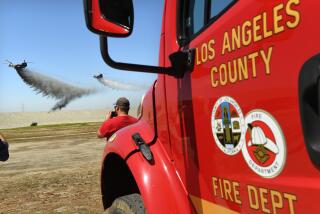New details emerge in fatal UCLA lab fire
A month after a fatal fire in his organic chemistry laboratory at UCLA, Professor Patrick Harran e-mailed a state investigator with his chilling recollection of rushing in to see Sheri Sangji, his critically burned research assistant.
She sat upright on the floor, her arms outstretched.
“I kneeled down and asked what happened,” he wrote Jan. 28. “She was panicky and said only there was a fire. I asked [a colleague] if he called 911 and he said yes. Sheri then began saying, ‘Where are they? Where are they?’ ”
Sangji, 23, suffered second- and third-degree burns over 43% of her body in the Dec. 29 fire. Her death 18 days later has raised questions about UCLA lab safety practices, as well as her training and supervision by Harran, a prominent researcher who joined the faculty in July.
His account is among a series of e-mails, investigation reports and other documents obtained by The Times through a California Public Records Act request. The records provide new details on the accident and on UCLA’s efforts to address its repercussions, including media inquiries.
In electronic missives to university colleagues, Harran complained that UCLA had all but hung him out to dry in the press. In one e-mail, he said that reports in two chemical industry publications “read like an indictment, without having the facts.”
In another, he took issue with a UCLA investigator’s report, which was detailed in a March 1 story in The Times. The report, citing previous lab deficiencies that had gone unfixed, made it “sound like I deliberately did not adhere to policy” and was part of a “culture of neglect,” he wrote.
In fact, Harran said, he had made as many of the corrections as he could, given that the lab was in the process of moving to another floor and was to be reinspected afterward.
In an e-mail criticizing the investigator’s findings, which included improper storage of flammable liquids, Harran cited the “pitiful state of the safety office,” adding that “they offered NO training for Sheri, but you don’t see that anywhere” in news accounts.
“I could go on and on, but I won’t,” he wrote. “Sheri was injured and died and I take responsibility. It hurts me deeply. But it just infuriates me the way the administration and staff are scrambling to protect their own [hides]. I will remember this.”
Kevin Reed, UCLA’s vice chancellor for legal affairs, said Tuesday that he thought Harran’s comment was made in a moment of candor and frustration. Reed added that the staff and administration aren’t protecting anyone, but rather are focused on improving safety on campus.
In response to Sangji’s death, UCLA launched a comprehensive review of lab safety protocols, stepped up inspections and shortened the time allowed to correct serious violations. Chancellor Gene Block also set up a campuswide lab safety committee and ordered new measures to enhance accountability.
“I believe we have to deal with this incident honestly and aggressively, making certain that we institute changes that will help prevent these types of accidents in the future,” Block wrote to UC President Mark Yudof in a Feb. 27 e-mail to give him a “heads up” on The Times’ March 1 story. “As a laboratory scientist, this accident is particularly painful for me.”
Harran was at a conference Tuesday and could not be reached for comment. In an earlier statement to The Times, he said he was heartbroken by Sangji’s death.
Sangji was transferring up to two ounces of t-butyl lithium from one sealed container to another when a plastic syringe came apart in her hands, spewing the chemical compound, which ignites instantly when exposed to air.
The resulting flash fire quickly consumed her clothing, including her highly flammable synthetic sweater, which was not covered by a protective lab coat as required. The Times reported in March that the earlier safety deficiencies in Harran’s lab included employees not wearing lab coats.
The lack of proper protective equipment is one of the issues at the heart of an investigation by Cal/OSHA, which could issue its findings as early as this week. Reed said Tuesday that he expects the agency to cite serious violations and impose substantial fines.
Inspectors from the university had previously faulted other labs in the Molecular Sciences Building where Sangji was burned for missing or inadequate safety gear. A week before Sangji’s injury, a graduate student in another lab suffered cuts and burns to his face and neck when an experiment went awry, another accident report stated.
The unidentified student, who was treated at Ronald Reagan UCLA Medical Center’s emergency room, told a university investigator that the explosion caused “glass, hot oil and chemical to fly toward my face, torso” and the surrounding area.
“When the incident occurred, I had my prescription glasses on, but not lab coat, gloves or safety glasses/goggles,” he said, adding that he had been trained in safety measures.
“I had safety training from my previous university,” he said, “but not from UCLA after I transferred here in 2007.”
--
More to Read
Sign up for Essential California
The most important California stories and recommendations in your inbox every morning.
You may occasionally receive promotional content from the Los Angeles Times.











